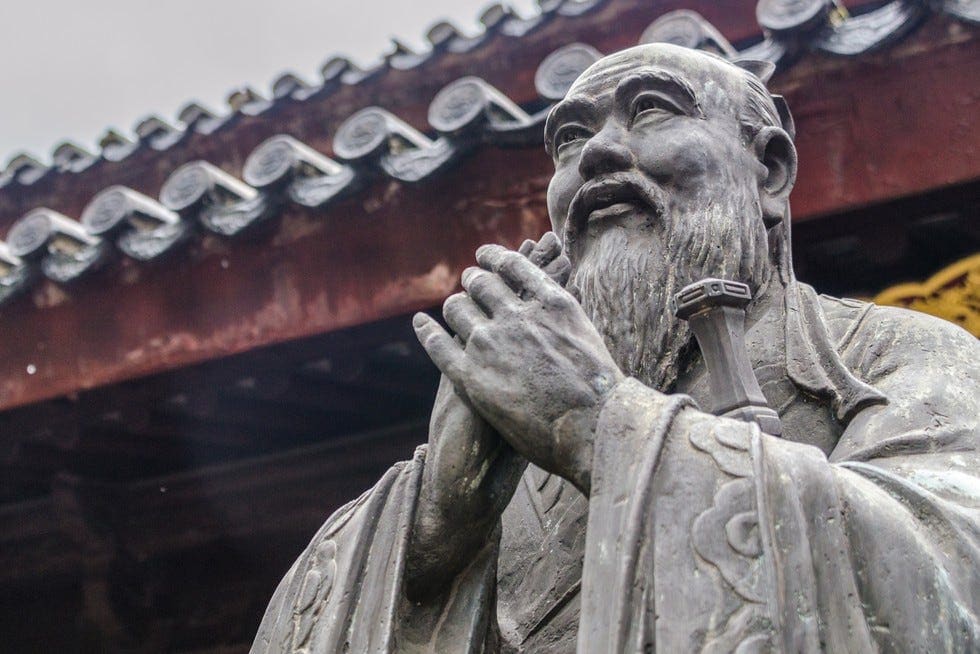Intro & Summary
This note examines the ethical and philosophical roots of China's AI development, influenced by Confucianism, Legalism, Taoism, and Communism. It contrasts China’s collective-focused AI ethics and governance with the Western emphasis on individual rights, highlighting differences in AI applications and public perception.
- First, I outline key philosophies in China as ethical sources.
- Then, I distill these ideas into 8 guiding principles.
- Next, I analyze legal texts that shape AI governance in China, illustrating how these principles connect ethics and governance.
- Finally, I explore a specific example of governance in tech deployment within society.
Why This Matters
China is on track to rival the U.S. in AI leadership by 2030, making it crucial for AI safety experts, international collaborators, and tech ethicists to understand the ethical foundations guiding China’s AI development. Yet, language barriers, limited access to primary sources, and contextual gaps often hinder the analysis of Chinese AI. This note seeks to bridge that gap by distilling key, accessible concepts from the Chinese perspective.
About the Author
This work is a restructured version of my PhD research in the philosophy of mind, originally in Russian. My background includes an MSc in applied math and graph theory with a minor in Chinese studies, and I am fluent in Mandarin. My experience in China and involvement with both local and international think tanks motivate this exploration of AI safety from an ethical perspective. Though I lack direct experience in ML or AI governance, I welcome feedback and discussion.
0. A brief Introduction to the role of ethics in AI
Ethics form the backbone of governance, providing the moral basis for decisions and actions. They act like the roots of a tree, shaping its growth, though external factors also play a role. While ethics can evolve, certain beliefs are deeply rooted in societies, making them valuable to examine.
In AI, ethics guide how ML technologies are used, determine who benefits (in line with cultural interpretations of "benefit"), and weigh risks. In China, Confucian values prioritizing collective good and social harmony differ from the individual-centered frameworks typical in Western AI development. Unlike most general-purpose tech, AI challenges established ethics, raising questions about what is beneficial and acceptable for society.
Thus, when discussing value alignment, it’s not enough to understand the values alone; it’s imperative to recognize their roots—a principle I believe should be emphasized more often in contemporary AI alignment discourse.
And now, to Chinese philosophies.
1. Philosophical Foundations of Chinese AI Ethics
Chinese philosophy offers a unique paradigm, rooted in ideas distinctly different from Ancient Greek or Christian thought. Covering this field fully here is impossible, so I’ll highlight core concepts rather than explore their historical contexts in depth.
My aim was not only to identify foundational philosophies but also to see how their principles appear in modern tech ethics. To do this, I systematically traced the influence of key concepts from Confucianism, Legalism, and Communism (with some reference to Taoism) in today’s Chinese AI ethics and governance.
1.1 Confucianism and Social Harmony
Confucianism is central to this discussion, originating in the 5th-6th centuries BCE. More than just a philosophy, it serves as a blueprint for societal harmony. Key principles of Confucianism include: Ren (仁) for humanity, philanthropy, or compassion; Yi (义) for justice, moral righteousness, or fairness; and Li (礼) for etiquette, proper conduct, or social rituals. In the context of AI, these values encourage a vision where technology serves the collective good, reinforcing social harmony and ethical governance.
1.2 Legalism and Governance
Legalism, an influential philosophy from the 4th-3rd centuries BCE, contrasts with Confucianism, emphasizing strict laws, centralized authority, and results-driven governance. Its core principles include law, order, and strong state control. In AI governance, this translates into strict regulation, centralized oversight, and prioritizing societal stability over individual autonomy.
1.3 Chinese Communism and Collectivism
Modern Chinese Communism integrates collectivist principles, emphasizing state-driven economic and technological control. In the AI context, this approach prioritizes state ownership and ensures that AI development benefits society as a whole, rather than solely individuals or corporations.
1.4 Taoism and Balance
Taoism, traditionally associated with Lao Tzu and the Tao Te Ching, subtly but powerfully influences Chinese thought. Key Taoist concepts include balance and harmony, with Wu-Wei (无为) for non-action; Ziran (自然) for spontaneity and authenticity; and Yin-Yang (阴阳) for balance and harmony. Taoist values could encourage AI development in alignment with the natural order, fostering equilibrium between technological progress and societal needs.
2. Key Ethical Principles in Chinese AI Governance
With an understanding of core philosophical teachings, we can now turn to jurisprudence. By examining key legal documents that shape China’s AI laws and practices, we can trace values rooted in these philosophies.
The most challenging—and interpretive—aspect of this analysis is to extract relevant principles without being able to consistently tie them back to specific sources. Much of this interpretation is nuanced, and the analysis here is my perspective.
Chinese AI governance reflects a synthesis of philosophical traditions, visible in its foundational documents and policy frameworks. These documents shape China’s AI strategy and embed ethical principles rooted in centuries of cultural and philosophical teachings. Key documents that reveal China’s approach to AI governance include:
- New Generation Artificial Intelligence Development Plan (新一代人工智能发展规划) — Issued by the Chinese State Council in 2017, this plan outlines China’s ambition to lead in global AI development by 2030. It emphasizes integrating AI with societal needs, aligning with Confucian ideals of harmony and collective well-being. The plan also highlights the need for ethical and legal frameworks to ensure safe and controlled AI development.
- Joint Pledge on Self-Discipline in the AI Industry (人工智能行业自律公约) — Drafted by China’s Artificial Intelligence Industry Alliance, this pledge emphasizes self-regulation among AI companies. It aims to balance innovation with social responsibility, reflecting the Legalist focus on governance and centralized control.
- Principles for AI Governance and Responsible AI (新一代人工智能治理原则——发展负责任的人工智能) — Issued by the Ministry of Science and Technology, this document prioritizes human welfare and ethical considerations in AI development, resonating with the Confucian value of humanity while also incorporating ideas of balance and collective good.
Each document highlights the importance of societal stability, safety, and collective progress, closely aligning with China’s broader political and cultural goals. I’ve extracted key ethical principles from these documents that are rooted in China’s longstanding traditions. Consider this a preliminary synthesis; a complete list would require deeper analysis by a Chinese studies & jurisprudence scholar—a “starter pack” for now, then.
Key ethical principles for AI gov drawn from Chinese philosophies. Try to look at them not as a MECE list, but rather as an array of accents.
- Harmonious Development ~ from Confucianism and Taoism, this principle emphasizes societal balance. How would different parts of society react when there's a change among any of them?
- Safety and Controllability ~ from contemporary Communist Party management strategies, this principle stresses secure and manageable systems.
- Human-Centricity ~ from Confucian ideals of humanity, this principle prioritizes human welfare. This principle I find especially interesting and important, as in Western cultures the notion of humanism is directly linked to Christian (and earlier) values, while in China it is rooted in a very different soil.
- Long-Term Prosperity ~ from Taoism’s Ziran, this principle stands for natural order, it emphasizes sustainable, forward-looking development. Again, I find a peculiar parallel with long-termism—would you spot it?
- Social Responsibility ~ from Confucian harmony and Legalist law-obedience, this principle stands for the collective responsibility of the society for itself.
- Justice and Equality ~ from Confucian honesty and Legalist legal ideals, this principle stands for fairness in dealings within society.
- Inclusiveness and Sharing ~ from Communitarian values, this principle focuses on communal benefit and shared, accessible progress.
- Collaborative and Flexible Management ~ from Confucianism, this final principle emphasizes how strategies can change and adapt, and the value of including different viewpoints in process design for this to happen.
While I inferred these principles from Chinese philosophies, direct connections to these roots aren’t always explicit in modern discourse. Often, these links emerged through contextual analysis rather than direct references. Next, I’ll provide an example of applying these principles for analysis.
3. A Short Case Study: Facial Recognition
China’s national AI strategy integrates efforts across multiple levels, from state government and local authorities to tech giants like Alibaba, Tencent, and Baidu, along with academic and research communities. This strategy places significant emphasis on AI ethics within a broader framework: objectives of AI research, funding sources, synchronization with policy, and ensuring AI safety and responsibility in the development and application of AI technologies. This comprehensive approach highlights how deeply these ethical principles are embedded in Chinese technological efforts.
China’s extensive use of facial recognition—ranging from enhancing security to streamlining consumer experiences (e.g., facial payment systems in stores and restaurants, police-accessible camera feeds, and fast-tracking processes in public transportation)—embodies the principle of Safety and Controllability. This technology enhances public security and operational control. Yet there is also an interplay with the Human-Centricity principle, which emphasizes human needs and comforts, as seen in the convenience that facial recognition brings to daily consumer transactions. The principle of Social Responsibility is another influential factor, with technology serving to support societal order. In this case, however, the balance leans heavily toward public safety, a contrast to regions like California, where privacy concerns have led to legislation restricting mass facial recognition.
This example serves as a straightforward illustration of how the same technology can be applied in vastly different ways, shaped by enduring norms and ethical principles.
Conclusion: Implications for AI safety
Understanding the philosophical and cultural distinctions between China’s collectivist approach and the West’s more individualistic ethics is critical for global AI safety efforts and dialogue. Bridging this divide is essential to fostering international cooperation in AI governance and mitigating the S-risk of misaligned AI within the context of the U.S.-China AI race.
Sources
- Artificial intelligence with American values and Chinese characteristics: A comparative analysis of American and Chinese governmental AI policies—by Hine, Floridi.
- The Chinese approach to artificial intelligence: An analysis of policy, ethics, and regulation—by Wang, Floridi et al.
- AI Nationalism—by Hogarth.
- Building ethics into artificial intelligence—by Yu, Shen et al.
- Deciphering China’s AI Dream: The context, components, capabilities, and consequences of China’s strategy to lead the world in AI—by Ding of the Future of Humanity Institute.



